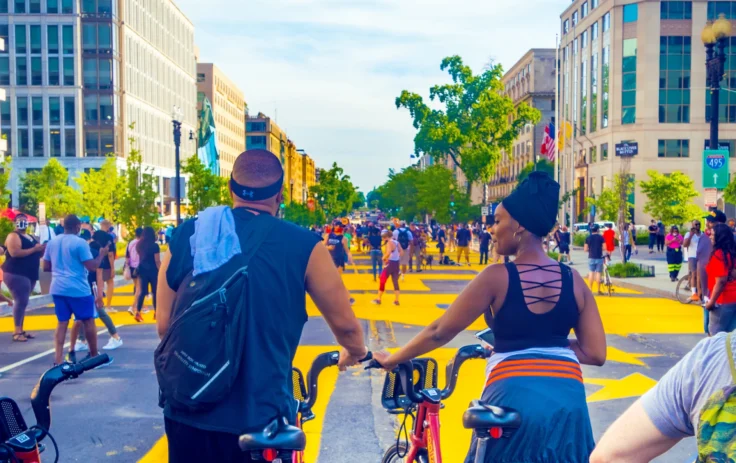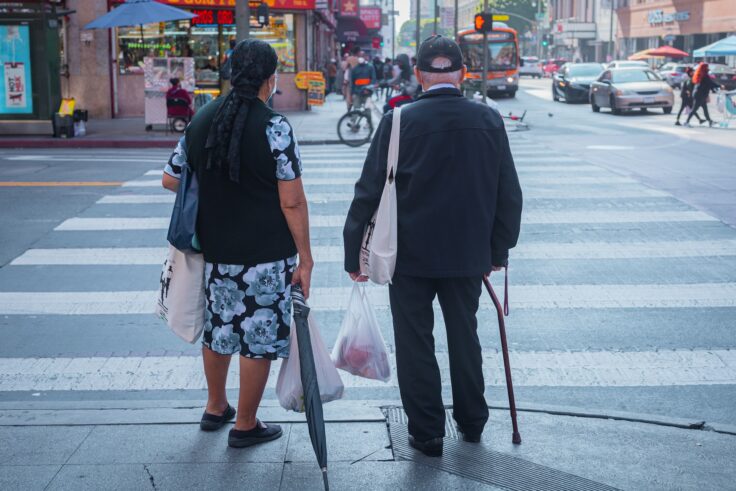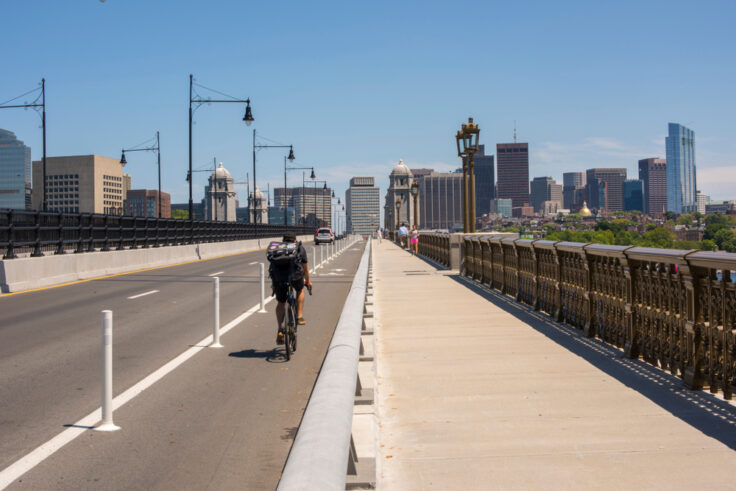June 17, 2023
Why Road Safety is an Issue of Race and Equity in US Cities
This Juneteenth, it is crucial that the transport community continues to acknowledge the inequitable impacts of urban planning on low-income communities of color across American cities, while also working to co-create solutions that make cities safer and more accessible for all.
Learn more about the history and significance of Juneteenth in the US here.
The number of people killed in road traffic crashes each year worldwide is estimated to be nearly 1.3 million — an especially disheartening statistic considering road traffic injuries are the leading cause of death for children and young adults globally. More than half of all road traffic deaths are among vulnerable road users such as pedestrians, cyclists, and riders of two-wheelers. Despite the mounting evidence that road safety policies and programs are critical to protecting people living in and moving throughout our cities, these efforts continue to face numerous challenges when it comes to implementation and enforcement as a result of conflicting priorities within city agencies, an overall lack of capacity, and weak accountability structures.
Prioritizing road safety is an intersectional issue that is not only about physical design but also social, economic, and political power. Solutions for road safety and collision prevention are not just about preventing the accidents themselves, but also in recognizing that safe streets are core to reducing transport emissions, improving air quality and public health, and ensuring equity in frontline communities. In the US, it is well known that the legacy of highway development has been the result of discriminatory planning practices that have disproportionately placed dangerous roads and thoroughfares directly within mostly low-income and minority communities.
We can see from existing conditions and data in major cities like Boston, Los Angeles, and New York City that the priority given to car- and speed-oriented streets has created a major health crisis in many Black, Brown, and minority neighborhoods — one that requires swift and collective action from our decision-makers to address.

Learn about strategies to ‘tame traffic’ through the reallocation of street space and parking reform in ITDP’s report here.
Los Angeles, CA
Following the 2020 uprisings for racial justice across the US and the world, more and more urban and transport planners are now interrogating the underlying relationships between transport, policy, and race. Often, people regard traffic deaths and fatalities as the result of individual decisions and isolated incidents. As with many transport issues, however, we know that the causes of inequities are part of a larger framework of programs, designs, and plans that have created flawed and unjust urban infrastructure. In a city commonly associated with ‘car culture’ in the US, Los Angeles is suffering from an epidemic of rising pedestrian deaths and traffic violence that disproportionately impacts people of color in low-income neighborhoods. Pedestrian deaths are up 36% in the city, even since the city’s Vision Zero policy was developed in 2015.
According to researchers at UCLA’s Lewis Center for Regional Policy Studies, Black residents in Los Angeles represent 18% of all collision victims — even though they account for only about 8% of the city’s population. According to the LA Times, a small number of streets, about 450 streets or 6% of the total network, account for 70% of serious injuries and fatalities and are also mostly concentrated in Black and Latino neighborhoods. As is the case in many US cities, Los Angeles has lower rates of car access and ownership amongst low-income people of color, leading to these populations walking and cycling in dangerous road conditions out of necessity. As we know, historic planning and underinvestment in communities of color have subsequently created street environments that emphasize drivers on expressways and multi-lane roads over those that walk, cycle, and use public transit — making these modes much more challenging and dangerous than they should be. The history of infrastructure inequality and the displacement of communities of color further from employment and essential services, often related to gentrification, only serves to exacerbate unsafe conditions on the road.
To begin to address these deeply-entrenched challenges, urban transport advocates have been calling for a more holistic ‘safe system approach’ to rethinking Los Angeles’ street networks, especially in neighborhoods where safety is as much a physical design issue as it is one of access and equity. This approach emphasizes multiple strategies for prioritizing sustainable, non-motorized transport while also encouraging speed-reduction and putting more protections in place for both pedestrians and drivers. Many of similar strategies are detailed in ITDP’s Taming Traffic report, and they include enhancing the safety and visibility of intersection design, expanding comprehensive networks of protected bike lanes, using stricter speed limits and enforcement measures, and making sure pedestrian infrastructure is made a priority, among other core elements. While these interventions are crucial for improving any US city, in a still sprawling and segregated metropolis like Los Angeles, taking a systems-level approach to road safety will make all the difference in ensuring the physical and social well-being of all of its residents.

Read the findings from ITDP US’ ‘Keeping Pace’ report on Greater Boston’s bus system here.
Boston, MA
In the city of Boston, the Roxbury neighborhood — a primarily Black community with over 55% of residents identifying as Black or African-American — has been severely underserved by regional public transit, despite having 36% of its residents fully reliant on transit to travel to and from their places of employment. Each year, the city of Boston sees 3,000 crashes that require emergency responses, and 71% of pedestrian crashes take place in environmental justice (EJ) designated communities like Roxbury. The neighborhood is one of the most dangerous areas for pedestrians and cyclists, and it is essential that the City put a stronger focus on road safety in order to promote more active mobility, reduce emissions in highly-polluted areas, and begin to address historical underinvestment in Boston’s EJ communities.
Last year, the City of Boston made a promising first step in tackling these issues when it secured $20 million USD in federal RAISE funds for the Roxbury Transportation Corridor project, which will reconstruct and upgrade three key transit corridors in Roxbury. Through the implementation of dedicated bus lanes, new sidewalks, new bus shelters, and separate and protected bike facilities, the City is hoping to reduce driving trips, promote walking and cycling, and co-create street plans that prioritize the movement of people rather than cars. These efforts to enhance road safety and neighborhood resilience will be further complemented by funds secured through the US Department of Transportation’s ‘Safe Streets and Roads for All’ Grant Program, which is going towards implementing necessary infrastructure to make nine local intersections safer and more comfortable for people who walk and cycle.
In a similar spirit, Boston’s Mayor also recently announced the Safety Surge Initiative dedicated to making streets across the city safer for all residents no matter the mode of transport. The implementation of speed bumps, improved intersection designs, and traffic signals across all local neighborhoods will address growing concerns around the protection of children and elderly residents from accidents. With the goal of redesigning nearly two dozen intersections a year, the City is demonstrating that it is able to leverage political will, proactive community outreach, and newly available federal funding programs to help develop more effective road safety strategies in the communities that need it most.

Read more about the importance of urban parking reform in ITDP’s on-street parking report here.
New York, NY
A 2022 study published by Harvard and Boston Universities found that Black pedestrians were more than twice as likely to be struck and killed by a vehicle as White pedestrians. In New York City, where the most dangerous streets are disproportionately found in historically Black and Latino neighborhoods, this trend is particularly evident. In fact, some of the most dangerous roads in the city are the result of deliberate redesigns in the 1940s that enabled high-speed traffic to travel through minority and low-income neighborhoods.
In hopes of addressing the ever-increasing speed of through-traffic in these areas, more than 100 organizations across New York are advocating for the passage of Sammy’s Law, which would allow the City to set its own speed limits and deliver safer streets and intersections across all five Boroughs. The law is named in honor of a 12-year-old boy who was killed by a speeding driver outside of his Brooklyn home in 2013. Still, over the past decade, more than 2,240 people have died due to traffic violence across the city. While speed bumps and similar physical measures may be effective on a single block, in a dense city like New York, regaining the authority to lower and control speed limits on all roads would empower local officials to widely regulate the speed of traffic and create calmer intersections by transforming broader governance structures.
When cars drive at lower speeds, the risk of major injury or death diminishes greatly, and this is a particularly urgent issue in historically Black and Brown neighborhoods where highway expansions and intentional street designs have continued to encourage speeding. Traffic calming through speed limit control is essential to promoting modal shift and enhancing safety for those who seek to walk or cycle rather than drive. With this understanding, New York City’s Mayor’s Office announced a $900 million investment in 2022 to specifically tackle the city’s traffic violence crisis and create more accessible, open public spaces for the city’s 8.5 million residents.
While the actual implementation of street reforms still have a long way to go, the City’s investment aims to advance statutory commitments of the five-year NYC Streets Plan that will greatly expand the mileage of protected bike lanes, dedicated bus lanes and busways, and pedestrian space across city streets. The Plan also takes a crucial new approach to reforming on-street parking guidelines and increases measures that de-incentivize speeding as part of a comprehensive strategy to reshape conditions around New York City’s busiest and most dangerous roads.

Given the alarming and rising trends related to traffic violence across communities of color in the US, it is clear that cities need to take more notice and action to address the persistent issues of urban infrastructure inequality and insecurity. We also know that the current conditions in the US are not insurmountable — we need only to look at other, less car-oriented cities in nations like France and Japan to see that change is possible — but it will require significantly more capacity and resource investment by those in power. Urban planners and policymakers urgently need to recognize road safety as both a climate solution and an equity solution, and not simply as the outcome of decisions made by individual drivers, pedestrians, transit riders, or cyclists.
Rather, the disproportionate amount of traffic fatalities that occur in low-income and minority neighborhoods is the result of systemic patterns of disinvestment and displacement that continue to favor car owners and road expansions over the safety and health of communities themselves. Yet there is hope: in some cities and areas where comprehensive Vision Zero plans are being implemented, we are beginning to see progress — but only in tandem with well-funded, sustained capital investments and policy commitments. Through ITDP’s own road safety efforts from Brazil to Mexico to China, we know that all cities can start shifting the paradigm by using creative and community-responsive interventions that reclaim urban space and emphasize the needs of people, rather than cars.
Join ITDP in advocating for safer transport infrastructure for cyclists and pedestrians all around the world.
